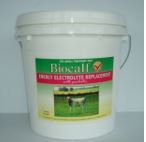Probiotics and Prebiotics for Calves
Prebiotics and Probiotics for Calves
There is some confusion in the marketplace as to what constitutes a probiotic or prebiotic and what these terms mean. The market for probiotics and prebiotics is considerable and growing, with declining acceptance of antibiotics in animal feeds and milk replacers.
Probiotics.
Probiotics aren’t new. In fact, they’ve been around for years. With a recent focus on antibiotic use, there’s a renewed interest in nutritional products that support dairy calf health. Probiotics for calves are one option, but what exactly are they? How and when should you use them?
Probiotics, Direct Fed Microbials (DFMs) and active microbials are essentially the same things – live micro-organisms defined as “good” bacteria. Probiotics for calves are micro-organisms which, when fed, may help improve digestion, calf performance and building of the immune system.
The World Health Organisation (WHO) defined probiotics as; “live micro-organisms that when administered in adequate amounts confer a health benefit on the host”. The most common micro-organisms used in probiotics are Lactobacillus species and Bifidobacter bifidis bacteria, although other minor bacterial species and yeasts may be present in some probiotic formulations. Lactobacillus species and Bifidobacter bifidis are generally regarded as the main probiotic components for human and animal use.
Prebiotics.
Prebiotics are selectively fermented, dietary ingredients that unlike probiotics, target the microbiota already present within the ecosystem, acting as a ‘food’ for the target microbes with beneficial consequences for host.
Prebiotics are currently being discussed by working parties of international scientific organisations such as the Food and Agriculture Organisation of WHO and the International Life Sciences Institute, and changes to the definition and concept may follow in time.
Three criteria are required for a prebiotic effect:
· Resistance of the prebiotic to degradation by stomach acid, mammalian enzymes or hydrolysis;
· Fermentation (breakdown, metabolism) of the prebiotic by intestinal microbes; and
· Selective stimulation of the growth and/or activity of beneficial microorganisms in the gut.
According to the International Scientific Association for Probiotics and Prebiotics, there are no probiotic standards in effect, making it difficult to define what is or isn’t a probiotic. However, there are guidelines in relation to the most common form of liquid probiotic, being yoghurt. The US National Yoghurt Association requires a minimum count of 100m cfu/g at manufacture and 10m cfu/g at expiry. (1m cfu/g is 1 million colony forming units per gram). Yoghurts have a relatively short shelflife; typically up to one month from date of manufacture. The majority of probiotics used in human and animal supplements are freeze-dried powders typically containing at least 10 billion cfu/g.
A search of the literature on probiotics indicates that survival of probiotic bacteria is a significant challenge in any medium. Best results are generally obtained through refrigeration, freezing, freeze drying or encapsulation techniques. Storage of probiotic bacteria in an aqueous medium at ambient temperature is likely to result in low survival. Even refrigerated yoghurts will only maintain probiotic bacteria at an acceptable level for several weeks. There do not appear to be any data supporting the use of unrefrigerated liquid mediums as a means of maintaining probiotic survival.
Probiotics powders for animal supplementation are generally “live” bacteria which are dried and remain viable in a dormant stage Once the bacteria are brought back into growing conditions (i.e. proper moisture, nutrients and temperature) they will start to grow in the “vegetative” state. In the paste form, they are held in an oil based carrier - not water based, therefore you don’t have growing conditions because there is no available water. Therefore, the bacteria remain dormant until they get into the gut conditions.
In addition, the bacteria are micro-encapsulated; this keeps moisture and oxygen away from the bacteria to enhance their survivability in the dormant state. The enzymes in the gut break down the micro-encapsular material - thus allowing the release of the bacteria so they can start to grow in the gut.
The four most commonly known species of naturally occurring lactic acid producing bacteria involved are, Lactobacillus acidophilus, Enterococcus faecium, Bifidobacterium longum and Bifidobacterium thermophilum.
L. acidophilus is probably the most widely known probiotic. It is considered as a very good bacteria - it colonizes the gut and is widely researched.
Bifidobacterium spp is considered the most beneficial of all probiotics by all standards. The Bifidobacterium strains are the ones human doctors favour for babies. Most researchers feel that Bifidobacterium gives the best perfomance of all the probiotic bacteria.
Enterococcus faecium is a beneficial bacteria found in the gut of the animal
What’s “good bacteria” good for anyway?
The gastrointestinal (GI) tract of a calf has a complex gut microbiome, which is a melting pot of bacteria in the gut. The good bacteria in probiotics support the microbiome to help build a strong immune system. How does this happen? Probiotics produce antibacterial compounds, such as acids and bacteriocins (antibiotic-like substances), which help strengthen the GI tract. Bad, disease causing bacteria are crowded out making room for good, immune-supporting bacteria. Research demonstrates that probiotics for calves have successfully decreased gut-related diseases and improved pre-weaned calf growth*.
When should you be feeding calves probiotics?
The simple answer? All the time. Consistently feeding calves probiotics through the pre-weaned phase provides an insurance policy to protect against unforeseen dairy calf health issues. Probiotics included directly in calf milk replacer help you rest easy knowing calves receive consistent levels of probiotics at every feeding. Sometimes calves need extra assistance. Probiotic supplements can provide a boost when calves need it most, like the critical first three weeks of life, or during feeding or housing transitions and cold and heat stress. In addition to continuous feeding of probiotics with milk replacer, providing a large dose of supplemental probiotics during times of stress can be beneficial for calves.
In March 2008, the International Probiotics Association established guidelines for probiotic labelling requiring:
1. Clear identification of the probiotic bacteria and strain present
2. Colony Forming Unit (CFU) count at the time of expiration (guaranteed minimum) of the product.
However these guidelines are not binding and there is no requirement for companies supplying probiotic products to comply with them.
ACVM registration
A number of products sold in New Zealand as probiotics have ACVM registration. This is not necessarily a requirement for oral nutritional compounds, but will indicate the product satisfies New Zealand Food Safety requirements for toxicity, safety, and residues. Registration does not relate to, or endorse, claims of efficacy or stability for these types of products. Efficacy is only considered by ACVM for products that make therapeutic label claims or where there are animal welfare or trade considerations.
Summary
In summary, there are a large number of products in the market, with a multitude of claims and trials. When determining which product to use one should identify the specific active ingredients, their concentrations, modes of action and data supporting product claims.
*Ballou, Michael. Enhancing Calf Immunity through Nutrition. Department of Animal and Food Sciences, Texas Tech University. 2013
Download the Prebiotics and Probiotics for calves. PDF.
BIOCALF Plus Provides energy, nutrients, minerals, probiotics, prebiotic yeast, enzymes and gelling agent Guar gum.
Click here to learn more about Biocalf Plus
BIOCALF Restore. Provides energy, nutrients, and minerals, at a low cost.
SITES OF INTEREST
Antahi Innovations Ltd Antahi Innovations Ltd are a company that specialises in innovative calf rearing solutions
Calf Notes Read the latest international research and information on calf rearing?
Calf Sessions A resource for calf health, nutrition, physiology and management
NZAGBIZ From colostrum management to health and biosecurity, experts from AgResearch and Fonterra discuss all things calf rearing.



